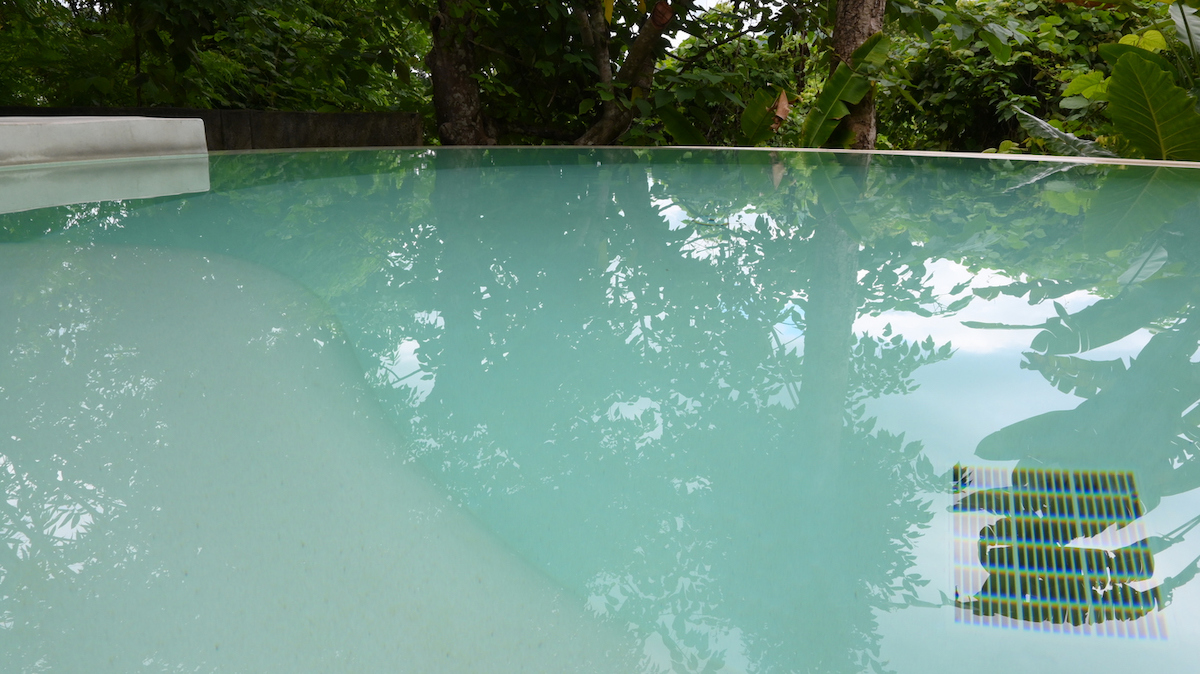We may earn revenue from the products available on this page and participate in affiliate programs. Learn More ›
Many pool owners struggle with cloudy pool water at least once every swimming season. A few common causes of cloudy pool water include poor filtration or circulation, low levels of free chlorine, other chemical imbalances, algae growth, or the presence of debris. The good news is that most of the fixes for murky pool water are relatively simple, but be forewarned that it may take some time, as well as some trial and error, to figure out how to clear a cloudy pool. If you’re wondering why your pool water is cloudy, read on to learn more about how you can remedy the situation.
Common Causes of Cloudy Pool Water and How to Fix It
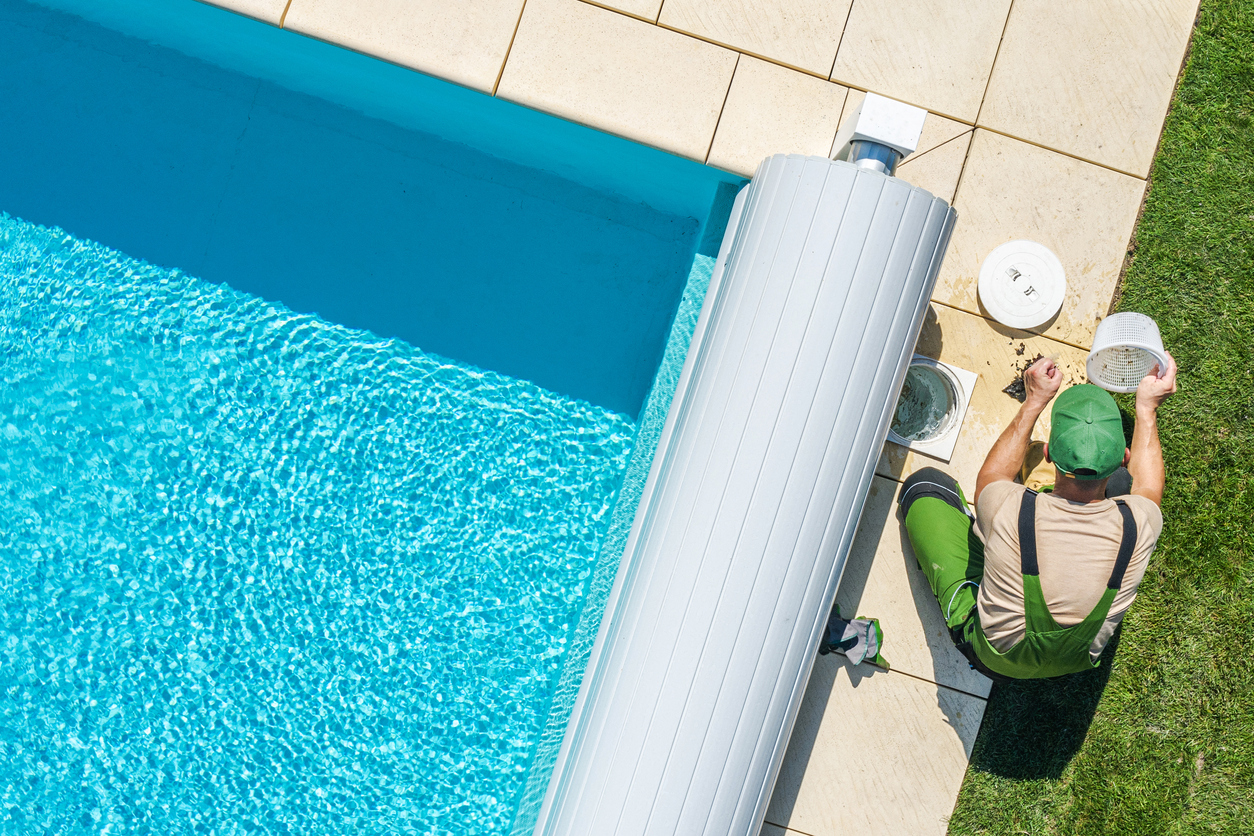
Why is your pool cloudy? The primary causes of cloudy pool water are insufficient filtration, inappropriate chemical usage, and accumulation of debris caused by environmental factors like nearby construction, trees, or wildlife. If you’re trying to figure out how to clear cloudy pool water fast, “a good first step is to make sure your pool filter is working properly,” says Rafi Friedman, president of Coastal Luxury Outdoors, a pool builder in Jacksonville, Florida. “If that checks out, the next thing to do is start testing chemical levels,” he suggests.
Filter and Circulation Issues
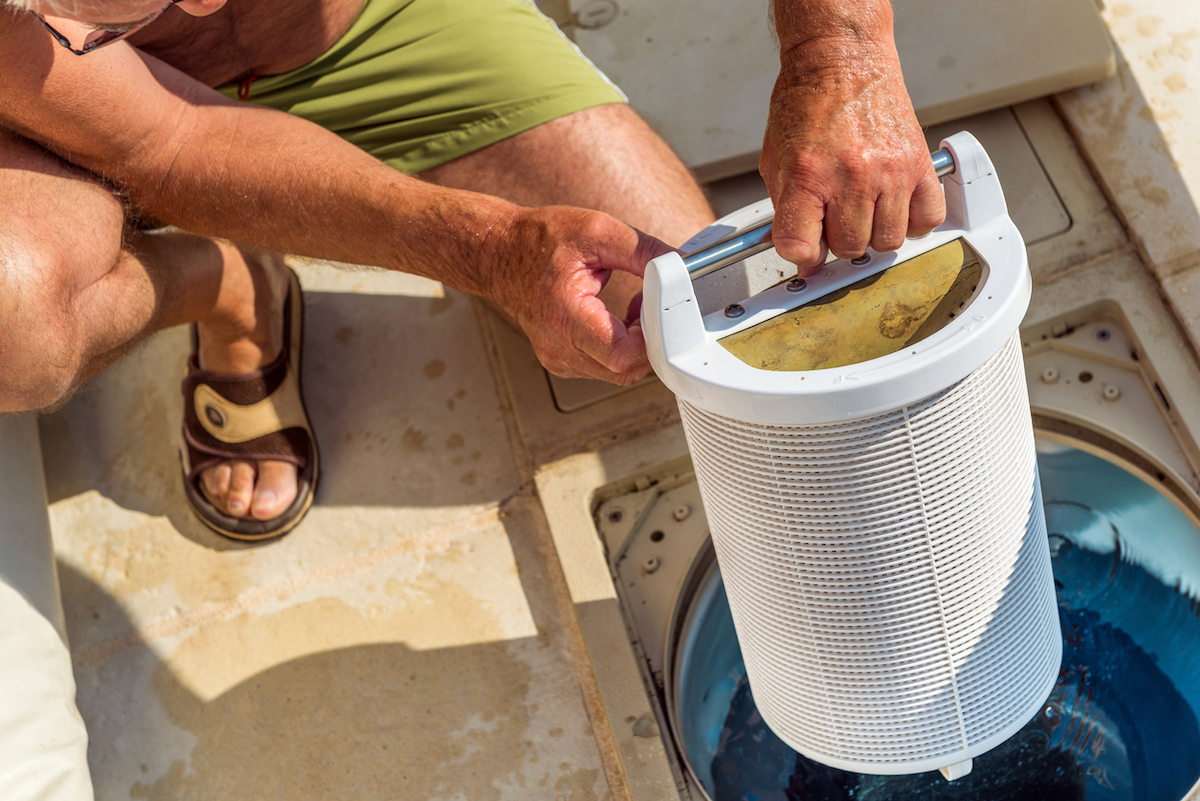
Cloudy pool water can be caused by pool filter and pump problems. First, confirm that the pump is operational, and make sure that you’re running the pump and filter system long enough each day—8 to 12 hours—to push all of the pool water through at least once per day. Also confirm that the return jets are angled slightly downward and away from the skimmer, all pointed in the same direction to circulate water around the pool.
A cloudy pool can also be caused by a clogged filter, worn-out filter media (whether sand, cartridge, or diatomaceous earth), or a full skimmer basket. For a clogged or dirty filter, clean the filter using the appropriate process and products for the type of filter you own. If you find that you need to run the filter system longer to keep the pool clean, or that you need to use more chemicals to keep the water clear, it may be time to replace the filter media. Also, regularly empty the skimmer basket and backwash the pump and filtration system to help prevent clogs. A clog in the skimmer line can reduce the flow of water through the filtration system and burn out the pump, so it’s important to turn off the system immediately when a clog occurs. To avoid further repairs, clear the clog or hire a pool repair professional to clear it before restarting the filtration system.
If you’ve checked the pump and filters, balanced the pool chemicals, and eliminated environmental causes as the source of the cloudiness, it’s possible that your pool pump or filtration system may be failing, or that your pump is not properly sized for your pool.
Chemical Imbalances
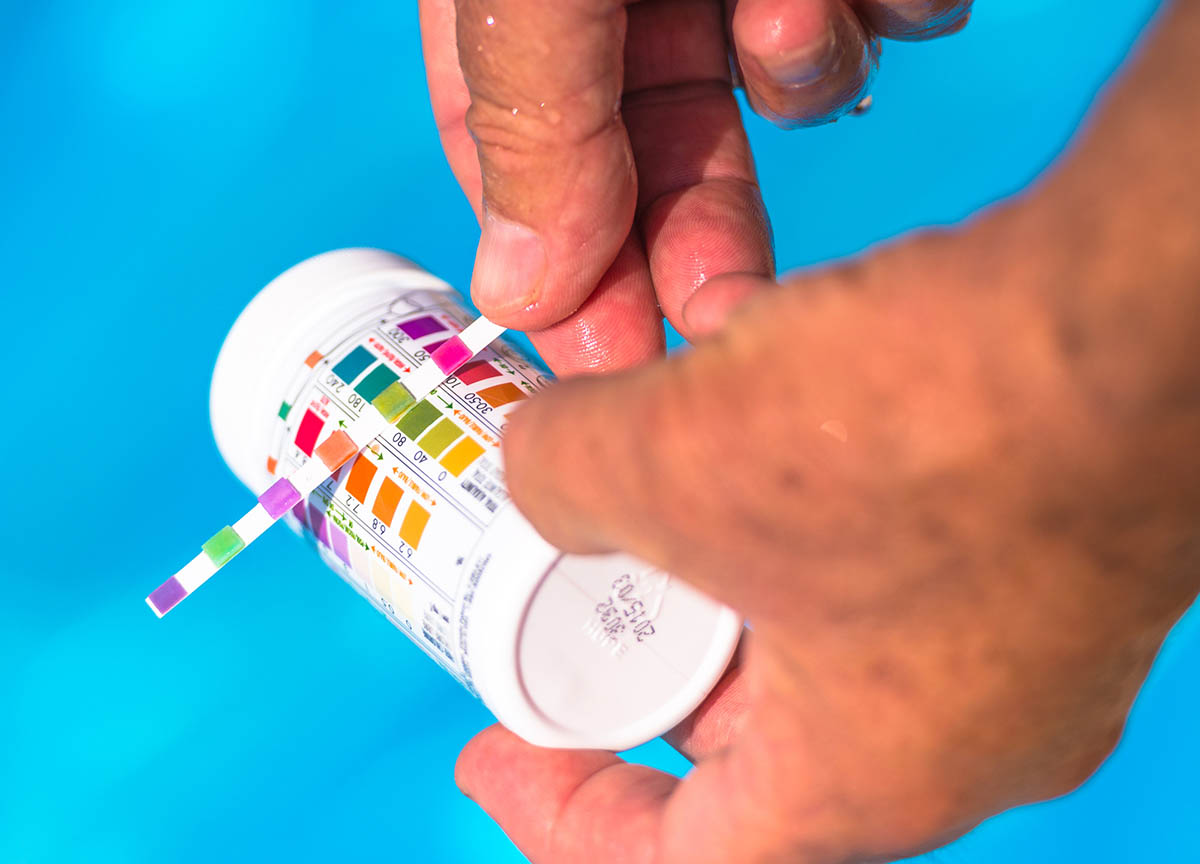
If your cloudy pool water is caused by problems with chemicals, you will need to restore the balance, typically by adding chemicals. “Once you identify the chemical imbalance, it may take 1 to 3 days [for the pool] to fully clear up,” says Friedman, “unless you can simply shock the pool with chlorine, but that won’t solve every issue.”
First Step, Testing: Regular testing is essential for keeping your pool clean, clear, and safe to use, so it’s crucial to invest in an accurate pool test kit. According to Friedman, “A good pool test kit is essential for identifying the cause of your cloudy water, since it could be caused by anything from algae to sediment to high pH, high alkalinity, high calcium hardness, or high chlorine levels.” The two most common types of tests are liquid test kits and test strips. Whichever you use, be sure to follow the manufacturer’s instructions carefully.
When working with pool chemicals, always follow the product directions and wear chemical-resistant gloves, safety glasses, long sleeves, and closed-toed shoes to protect yourself from splashed chemicals.
Chlorine: In treated pool water, chlorine is present in two forms: free and combined. Free chlorine is available to sanitize contaminants, while combined chlorine has already reacted with contaminants—in a sense, it’s “used up.” An overwhelming smell of chlorine may indicate a build up of chloramines, a type of combined chlorine, in the water.
While many different chemical imbalances can cause cloudy pool water, “in most scenarios, an insufficient free chlorine level is to blame,” according to Alicia Toedter, pool care education and content leader at Leslie’s, a nationwide pool supply company.
In a clear pool, the amount of free chlorine will be about the same as total chlorine. Free chlorine should always be higher than combined chlorine (total chlorine minus free chlorine). A cloudy pool may be the result of too little free chlorine in a pool, which can contribute to rapid algae growth.
In balanced pool water, free chlorine levels should range between 1 and 3 parts per million (ppm); bromine, a sanitizer that is often used in hot tubs and indoor pools, has a slightly wider range, between 2 and 6 ppm. If the levels are too low, shock the pool with a high level of chlorine (or bromine) to rapidly return the pool water to a balanced level.
Powdered shock needs to be mixed with water according to the manufacturer’s directions; liquid shock can be poured directly into the pool. This should be done around dusk so sunlight won’t affect the chemicals as they work. Pour along the edges of the pool, moving completely around it so the shock gets distributed evenly in the water. Run the filter overnight, and keep it running until the pool is clear. If there was heavy algae in the pool, this could take several days.
If your pool is green and cloudy, the culprit may be algae, which can spread quickly on sunny days. If you’re dealing with early-stage algae growth, an algaecide or pool clarifier may fix the problem. A significant algae bloom will require cleaning and shocking the pool. For persistent algae problems or black algae, call in a pool service pro.
Alkalinity and pH levels: Test kits measure other levels, including total alkalinity and pH levels. High alkalinity and pH levels that are either too low or too high can result in cloudy water. High alkalinity in particular can lead to bacteria growth and other safety issues. High pH often indicates excess calcium deposits, and low pH is often a sign of too much combined and insufficient free chlorine. The total alkalinity of the pool should remain between 80 and 120 ppm, and the pH needs to be monitored.
- A pH between 7.2 and 7.8 is best.
- A pH between 7 and 7.8 is safe.
- A pH lower than 7 is considered acidic and can cause itching, burning, and rashes.
- A pH balance above 7.8 is a basic solution that can burn and irritate the eyes.
You can raise the pH and alkalinity by adding alkaline products like sodium bicarbonate (baking soda), or lower it with chemical additives like muriatic acid or sodium bisulfate.
Calcium: Many outdoor pools have hard water, which contains minerals like calcium and magnesium that leave residue behind. Very high calcium hardness levels can lead to cloudy pool water. Excess calcium will also visibly scale the pool walls, and it can clog the filter with hard mineral deposits, preventing the filter from doing its job.
Calcium hardness should fall between 200 and 400 ppm. To lower the calcium level, partially drain the pool (lower the water level by about a foot) and refill it. In addition, adding a flocculant to the water can cause the excess calcium to clump together and sink to the bottom of the pool, where it should be vacuumed up or filtered out. To increase calcium hardness, add calcium chloride to the pool water.
Cyanuric acid: Cyanuric acid is a stabilizer that prevents chlorine from breaking down under direct sunlight, which depletes the free chlorine and produces harmful chloramines. Levels of cyanuric acid should be kept between 30 and 50 ppm. Levels can be lowered by partially draining the pool and refilling it with clean water. Raise the levels by adding a stabilizer with cyanuric acid or chlorine tablets that come with a stabilizer in the formula.
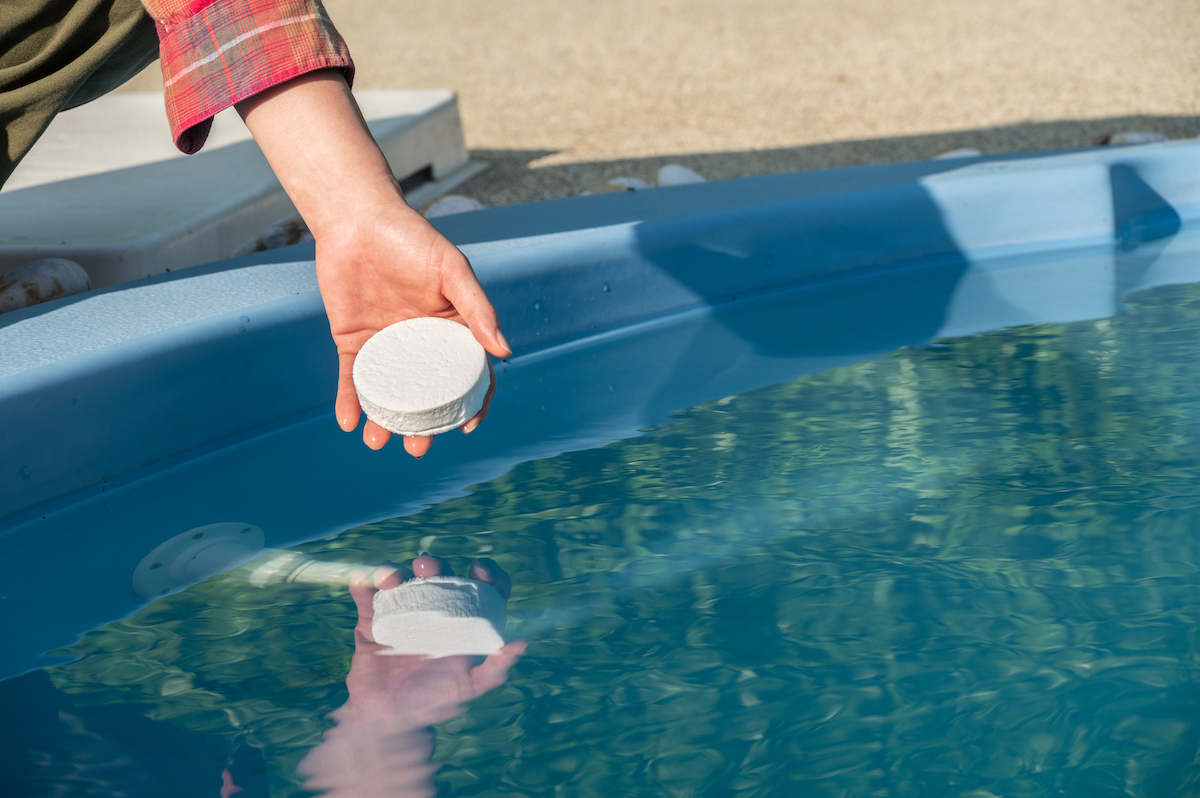
Environmental Factors
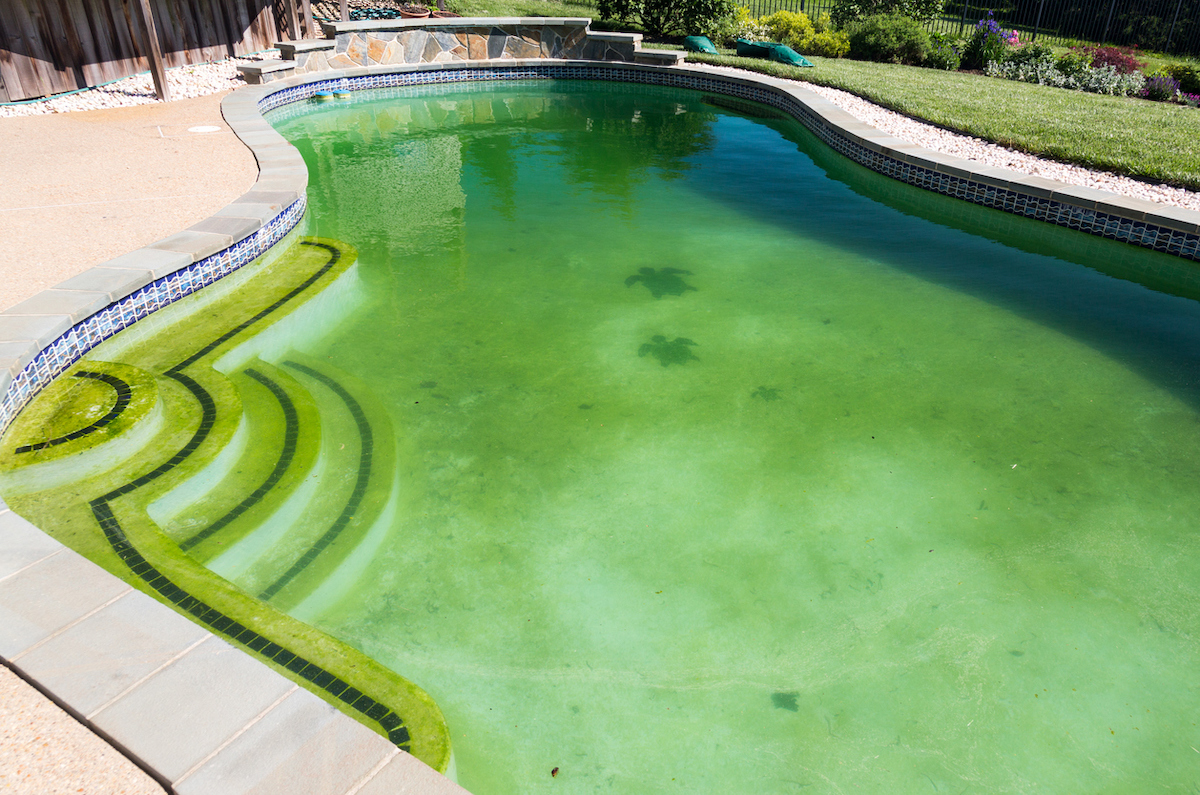
Construction and severe storms can dump high levels of dirt, dust, and debris into the water. Heavy rainfall can dilute the pool water, lowering levels of free chlorine and resulting in cloudy water. Feathers, pollen, and other organic matter can cloud the water and make it difficult for the filter to clean the water quickly, and some of this debris can contain phosphates, which promote algae growth. But people, with their body oils, hair, dirt, makeup, and skin products, may be the most significant factor affecting pool water quality.
Fortunately, fixing environmental issues is typically as easy as adding a pool clarifier to the water. This chemical acts as a coagulant, bonding together the loose dirt, pollen, and other small particles. This makes it easier for the filtration system to capture the debris. Once you’ve applied a pool clarifier, depending on the type of filtration system you have, it may take a few days for the water to clear up.
Despite your best efforts, some environmental factors, such as nearby construction or resident wildlife, may be outside of your ability to control. If your pool is frequently contaminated, make clarifying your pool part of your regular pool maintenance to help protect the quality of the water.
How to Prevent Cloudy Pool Water
After your pool water issues are solved and the water is clear again, take steps to keep it that way. Testing and balancing the pool water is key to keeping a pool clean, safe, and beautiful. Toedter advises, however, that at the height of the season, “when temperatures are the warmest, algae activity is at its peak, and swimmers are using the pool most often, more frequent testing may be necessary to ensure the water stays balanced and sanitized, as water chemistry can change daily.”
- Check the jets in the pool to make sure that they are angled slightly downward and all in the same direction so the pool water circulates through the filtration system.
- Run the pump and filter for at least 8 hours every day during swimming season, and backwash the pool filter once a week.
- To deal with ongoing environmental factors, use a clarifier regularly.
- Test the pool water two to three times per week to ensure that the chemical composition is balanced. If the tests indicate an imbalance, add the appropriate chemicals to the pool to return the pool water to a balanced state. Optimal pH for pool water is between 7.2 and 7.8, and optimal chlorine concentration is between 1 to 3 ppm.
By devoting just a little time to regular testing and pool maintenance, you’ll be able to keep repairs and other headaches to a minimum while you maximize your time relaxing around the pool, cooling off in the water, and living the good life. Isn’t that why you decided to invest in a pool in the first place?
FAQs
It’s best to stay out of a cloudy pool. Toedter points out that cloudy pool water is not just an aesthetic issue; it also poses health and safety risks. Cloudy water can obscure swimmers, making it difficult to notice emergency situations. “It can also harbor harmful bacteria, increasing the risk of recreational water illnesses,” she adds. At the very least, cloudy water can cause swimmers to experience red eyes, irritated skin, and rashes. So clear up the cloudy water before diving back into the pool.
If the cause of the cloudiness is insufficient free chlorine or other sanitizing agent, then shocking the pool should clear up cloudy pool water. If it doesn’t, the root cause may be poor filtration, some other chemical imbalance, or an environmental factor.
It can take between 12 and 24 hours for the sanitizer to circulate through the pool, so your pool water may not clear up immediately. If the water is still cloudy after 24 hours, look for a different cause of the cloudiness.

